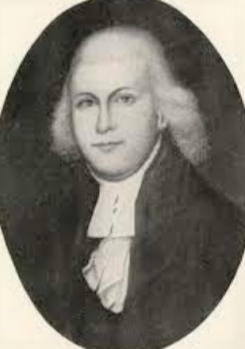Title: Pastor, Revolutionary War chaplain, professor
Birthdate: July 22, 1751
Death Date: April 7, 1824
Plot Location: Section 112, First Baptist Church plot

 A section of Mount Moriah Cemetery was purchased by the First Baptist Church (FBC) of Philadelphia in 1859 because they wanted to relocate the burial ground from their former property at 218 Arch Street. This obelisk in the middle of Section 112 honors those men who pastored the church from 1744 to 1889 when the monument was erected.
A section of Mount Moriah Cemetery was purchased by the First Baptist Church (FBC) of Philadelphia in 1859 because they wanted to relocate the burial ground from their former property at 218 Arch Street. This obelisk in the middle of Section 112 honors those men who pastored the church from 1744 to 1889 when the monument was erected.
One such pastor, Henry Holcomb, whose Notable story is found here, served first in a Revolutionary War militia before devoting himself to church work. By contrast, William Rogers served as FBC’s third full-time pastor, then became active in the war as a chaplain.
William was born in Newport, Rhode Island and in 1765 he became the first student of Rhode Island College (now Brown University). In fact, for the first year there, he was the only student. He received the degree of A.B. in 1769 and then an A.M. degree in 1772 while employed as principal of an academy in Newport.
That same year he was ordained and moved to Philadelphia as pastor of FBC. He found his soul’s mate there, Hannah Gardner, and a June wedding was held in 1773. They would eventually have three daughters.
Tensions were rising in those years over England’s oppressive colonial rule. The First Continental Congress met at Carpenters Hall in 1774. One of the church deacons, Samuel Miles, was raising a militia, the Pennsylvania Rifle Regiment. Rev. Rogers decided to leave the pulpit at the end of 1775 and join the unit as chaplain. “Colonel Miles,” as he was known, has his own Notable story, found here.
It’s been said a military chaplain is like a pastor without walls. In 1778 Congress appointed him chaplain of the Continental Army’s Pennsylvania Brigade where he remained until 1781. Three churches of different denominations in other cities then sought him out to be their pastor but he decided instead to fill in among the smaller and struggling congregations in Philadelphia.
After several years in that role he became professor of oratory and English literature at the College of Philadelphia, which became the University of Pennsylvania. He taught there from 1789 to 1811, and was awarded an honorary doctorate degree.
When the pastor of FBC died in 1803, “Reverend Rogers” filled in for two years while as “Professor Rogers” he continued his teaching duties at the college. During this time the church’s first choir was formed and “daughter churches” were organized in the Northern Liberties and Blockley townships of Philadelphia County.
William Rogers was active in networking with other churches as part of the Philadelphia Baptist Association. In 1813 he joined then-FBC pastor, Henry Holcombe, on a committee that created the Philadelphia Baptist Society for Foreign Missions, later known as the American Baptist Foreign Mission Society.
Other activities included serving as vice-president of the Pennsylvania society for the gradual abolition of slavery; vice-president of the Philadelphia society for alleviating the miseries of public prisons; and chaplain of the Military Legion of Philadelphia in 1805. He was also elected to the Pennsylvania legislature in 1816, and became a member  of the Religious Historical Society of Philadelphia in 1819.
of the Religious Historical Society of Philadelphia in 1819.
After his death in 1824 the former pastor was buried in the FBC cemetery, which was relocated to Mount Moriah in 1860.

Support the Friends of Mount Moriah
Help us in our mission to restore and maintain the beautiful Mount Moriah Cemetery by donating to our cause or volunteering at one of our clean-up events.

